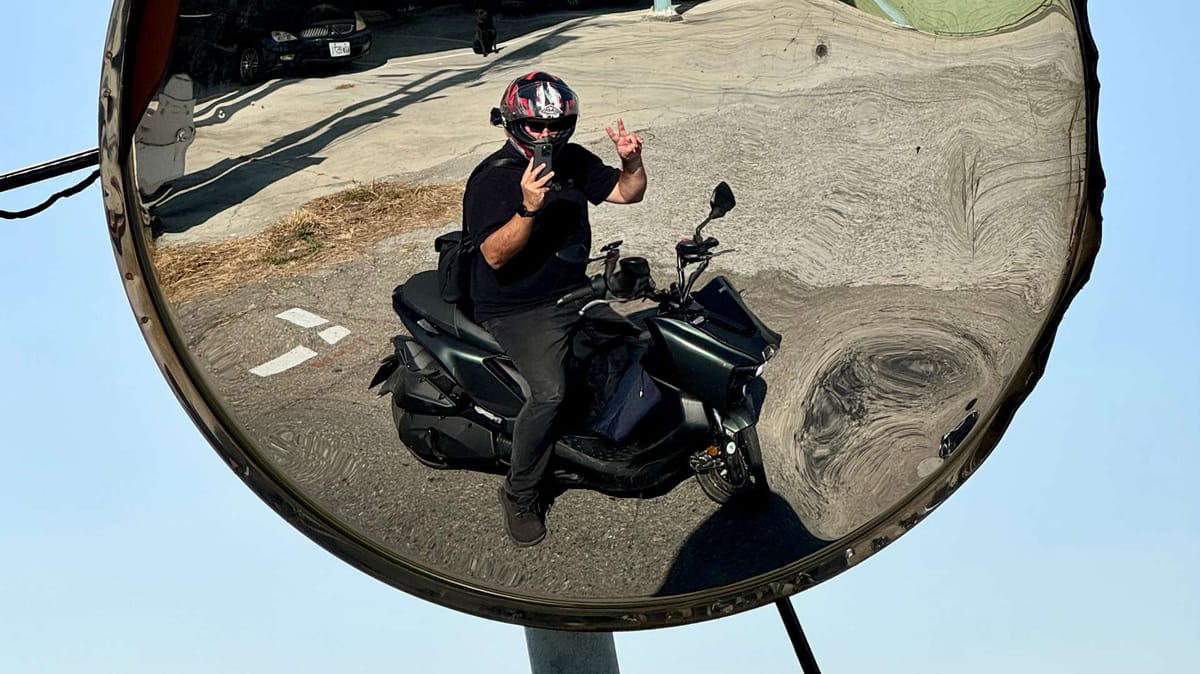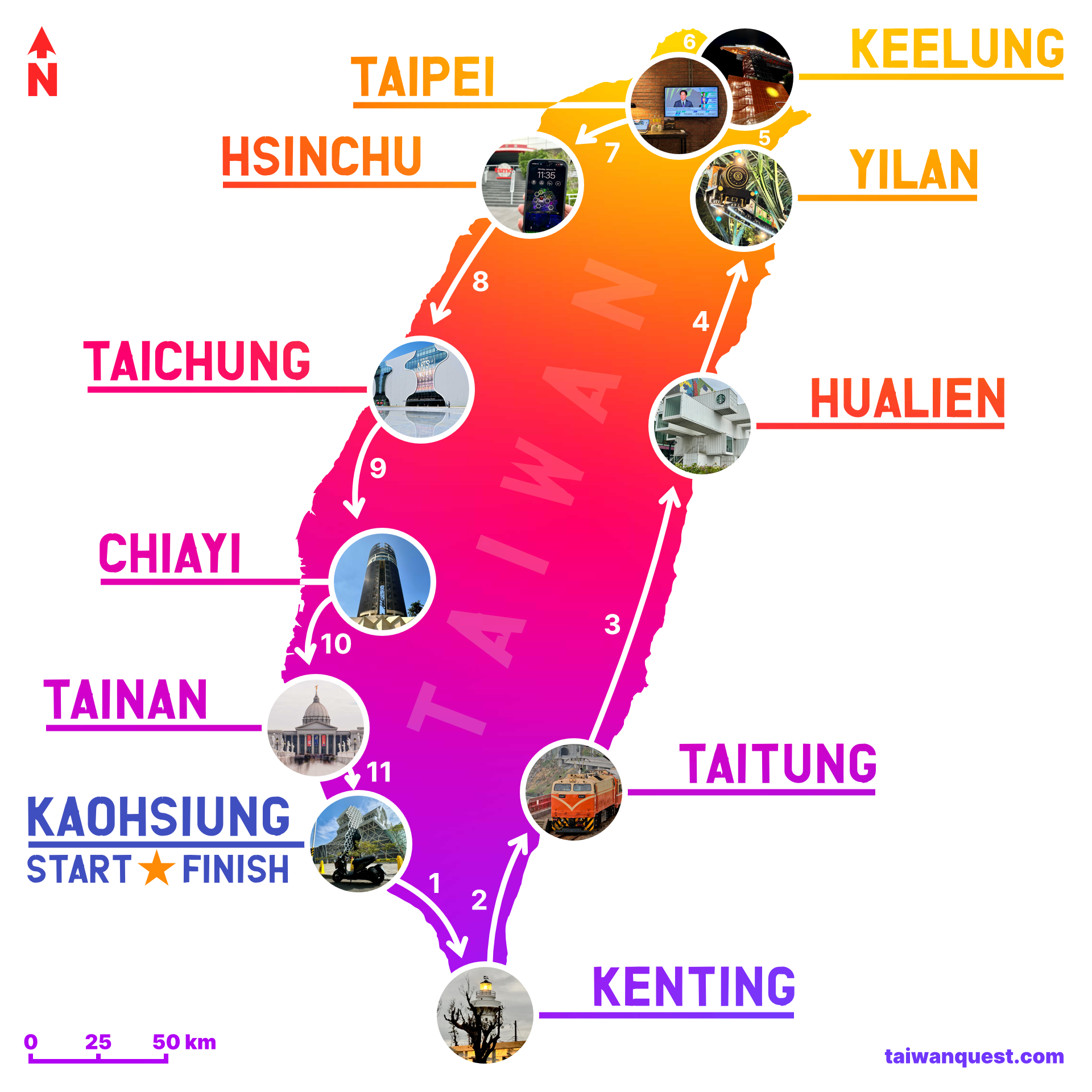Reflections on huandao
Three months ago, I returned from my solo circumnavigation of Taiwan by scooter. Here are my thoughts…

A huandao (literally “around the island”) is considered a rite of passage or step towards enlightenment, by many in Taiwan.
It can be undertaken on foot or bicycle, by train or by car, or—in my case—on a 160cc scooter.
Some of my Taiwanese friends completed a huandao after university, usually in groups, sometimes two people per scooter. A friend-of-a-friend completed a scooter huandao in just two days(!)—a feat of caffeine-fueled seated endurance, which didn’t appeal to me or my butt.
(One hour on a scooter feels like three hours in a car. The scooter’s much more fun, and much more tiring.)
I undertook my huandao in January to celebrate my one-year anniversary of living in Taiwan.
Over 11 days, I traveled 1,460km.
I caught up with friends in Hsinchu, New Taipei City, Tainan, Taitung, and Yilan. Taiwan is small, and people I’ve met in Kaohsiung live all over the island. I cannot express how lucky I am to know them.
On the road, I covered just 30 or 40 kilometers each hour. Sub-550cc motorcycles aren’t allowed on freeways, and everywhere else has a speed limit of 30–70km/h. And a lot of traffic lights.
I carried a camera and lenses, a laptop, and a power brick on my back. Hanging below the dashboard were my tripod, a rucksack with wet weather gear, food, and water.
And in the under-seat compartment, my clothes.
(I took more than the average huandao’er: it’s extremely hard to find shoes, and somewhat difficult to find clothes, that fit me in Taiwan—so I brought extras of everything, just in case. Most people would also eschew the camera gear and laptop if they weren’t a hobbyist photographer who was blogging daily…)
My SYM MMBCU scooter is optimized for longer journeys, and was supremely comfortable. But that didn’t stop me getting wrist ache part-way through. I alleviated this by wearing gloves and—in situations where I was unlikely to brake—adjusting my grip in bizarre and creative ways. But that was my only issue for the entire ride, which otherwise comprised non-stop, undeniable, can’t-believe-I-waited-this-long, joie de vivre.
Starting from Kaohsiung, I hooked south through Kenting National Park; rode up the mountainous east coast; through the Keelung–Taipei–New Taipei metro area in the north; and back via a string of large cities on western plains:

This was a good route. Riding counter-clockwise meant I was on the seaward side of the road. But if I was starting over, I’d add a stop on the 180km / 6-hour stretch from Taitung to Hualien.
(Remembering that one hour on a scooter feels like three in a car…)
For New Zealanders, Taiwan’s scale looks inconsequential: it’s only one-quarter the size of Te Waipounamu/the South Island. But, whereas 50km in New Zealand can flash by in 30 minutes, here, on a sub-550cc motorbike, with reduced speed limits and all the red lights, the same distance takes two-to-four times as long.
From my dashcam footage, I edited out dozens of long waits at intersections. This left me with eleven 10-to-20-minute videos (at 10× speed), covering the entire trip.
Here’s a trailer:
You, too, can enjoy 1,460km of dashcam footage (mercifully at 10× speed), at youtube.com/@taiwanquest.
So, about that step towards enlightenment…
I had two realizations on my journey.
Both could be minor or profound, depending on your point of view.
For me—one year and one hemisphere removed from my life in New Zealand—these realizations were unexpected and deeply meaningful.
Realization 1: Everything’s normal
Somewhere between Taitung and Yilan, there was a moment when—and I don’t know why this suddenly struck me—I noticed everything had become normal.
My brain was no longer working overtime to emulate local behavior. I wasn’t anxious about ambiguous parking spots, or unsure if I should clear my own plates.
I was casually and freely (in a very limited, very unsophisticated way) speaking Chinese with strangers.
And everything around me—from vernacular architecture to road signs that aren’t yellow; from coconut trees to betel nut stalls; to weaving through traffic and going with the flow (on bike or on foot)—had become completely normal.
I’d lost my sense of feeling like a foreigner. Or of things feeling different.
On the north-east coast of Taiwan—a part of the world I’d never seen before—everything was comfortable and familiar.
It feels natural and appropriate and inexorable, to be here right now.
Realization 2: I’m emotionally attached
On the last day, riding from Tainan to Kaohsiung, it wasn’t clear where one city ended and the next began. But as I approached the city center, and then saw Monkey Mountain in the distance, I experienced a stirring sense of home.
Stopped at a red light, with the mountain ahead of me, I actually wondered if I should update my pepeha. A strange thought to have, but then again, ‘home’ and ‘pepeha’ are conceptually related…
During my journey, I was fortunate to see a lot of Taiwan—including its largest cities and its northern-, southern-, eastern-, and western-most points.
This whole island is incredible. But, Kaohsiung’s where I want to be.
Thankfully.
Because it would be awkward otherwise.
